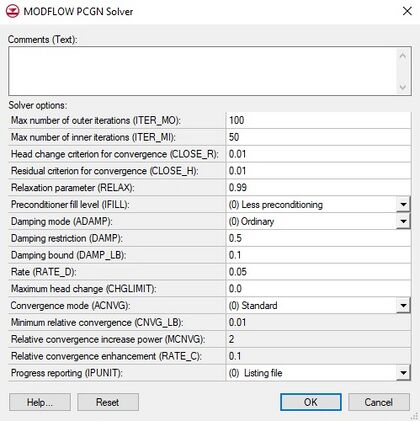GMS:PCGN Package: Difference between revisions
From XMS Wiki
Jump to navigationJump to search
No edit summary |
No edit summary Tag: Manual revert |
||
| (5 intermediate revisions by 2 users not shown) | |||
| Line 1: | Line 1: | ||
{{MODFLOW Links}} | {{MODFLOW Links}} | ||
The PCGN package or Preconditioned Conjugate Gradient Solver with Improved Nonlinear Control is one of the solvers available for MODFLOW-2005. Using the PCGN solver a specific GMS MODFLOW executable (mf2k5_..._parallel.exe) can be run with parallel processing on a single machine (though not across multiple machines on a network) greatly reducing run time. | The PCGN package, or Preconditioned Conjugate Gradient Solver with Improved Nonlinear Control, is one of the solvers available for MODFLOW-2005. Using the PCGN solver a specific GMS MODFLOW executable (mf2k5_..._parallel.exe) can be run with parallel processing on a single machine (though not across multiple machines on a network) greatly reducing run time. | ||
The ''MODFLOW PCGN Solver'' dialog has the following options: | The ''MODFLOW PCGN Solver'' dialog has the following options: | ||
| Line 18: | Line 18: | ||
* ''Damping restriction (DAMP)'' – Restricts the damping parameter θ. Generally is set to be between 0 and 1. | * ''Damping restriction (DAMP)'' – Restricts the damping parameter θ. Generally is set to be between 0 and 1. | ||
* ''Damping bound (DAMP_LB)'' – Represents a bound placed on θ. | * ''Damping bound (DAMP_LB)'' – Represents a bound placed on θ. | ||
* Rate (RATE_D) | * ''Rate (RATE_D)'' – If using adaptive damping, sets the recovery rate for the damping factor θ in response to the progress in the Picard iteration. If using enhanced damping, adjusts the damping factor θ upward. | ||
* ''Maximum head change (CHGLIMIT)'' – Limits the maximum head change applicable to the updated hydraulic heads in a Picard iteration. | * ''Maximum head change (CHGLIMIT)'' – Limits the maximum head change applicable to the updated hydraulic heads in a Picard iteration. | ||
* ''Convergence mode (ACNVG)'' – Defines the mode of convergence applied to the PCG solver. | * ''Convergence mode (ACNVG)'' – Defines the mode of convergence applied to the PCG solver. | ||
** (0) Standard | ** (0) Standard | ||
** (1) Adaptive | ** (1) Adaptive – This option requires a valid value for variable CNVG_LB. | ||
** (2) Enhanced | ** (2) Enhanced – This option requires valid values for variables MCNVG and RATE_C. | ||
* ''Minimum relative convergence (CNVG_LB)'' – Requires adaptive convergence mode. The minimum value that the relative convergence ε is allowed to take under the self-adjusting convergence option. | * ''Minimum relative convergence (CNVG_LB)'' – Requires adaptive convergence mode. The minimum value that the relative convergence ε is allowed to take under the self-adjusting convergence option. | ||
* ''Relative convergence increase power (MCNVG)'' – Requires enhanced convergence mode. Increases the relative PCG convergence criteria by a power equal to MCNVG. | * ''Relative convergence increase power (MCNVG)'' – Requires enhanced convergence mode. Increases the relative PCG convergence criteria by a power equal to MCNVG. | ||
| Line 35: | Line 35: | ||
[[File:MODFLOW-PCGN.jpg|thumb|none|center|420 px|The ''MODFLOW PCGN Solver'' package dialog.]] | [[File:MODFLOW-PCGN.jpg|thumb|none|center|420 px|The ''MODFLOW PCGN Solver'' package dialog.]] | ||
{{Navbox GMS}} | {{Navbox GMS}} | ||
[[Category:MODFLOW]] | [[Category:MODFLOW]] | ||
